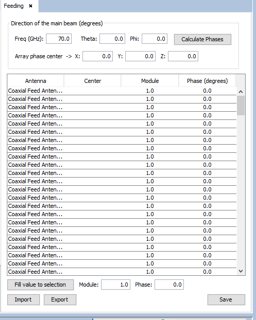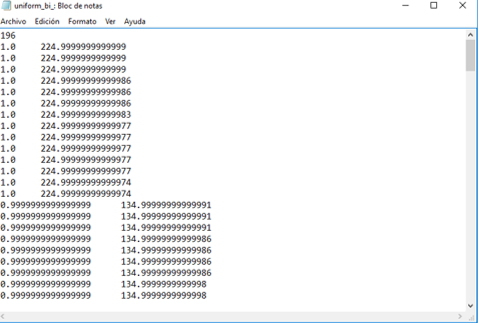Example 3: 14x14 Coaxial Feed Array with Uniform Algorithm
This case explains how to use the uniform algorithms to calculates the pointing parameters in a bidimensional coaxial feed array.
Step 1 Create a new MoM Project.
Open newFASANT and select File - New option.

Select MOM option on the previous figure and start to configure the project.
Step 2 Set the simulation parameters as shown.
Select Simulation - Parameters option, set the parameters and save it.

Step 3 Create the array
First, select 'milimeters' on units list on the bar at the bottom of the main window.


Select the surfaces and click on Add.

Then save the feed point.
Use the array command and enter the characteristics of the array.


Step 4 Feed the array
To set the feeding of the array select Source - Antenna Feeding and the following panel will open.

This is the default setting. To use the uniform algorithm click on Tools - User Function and select the corresponding function. NOTE To use the bi-dimensional uniform function it is needed to download both the bi-dimensional and the unidimensional functions.

A path has been selected by default so the files will be created on the mydatafiles folder in the newFASANT directory.

The next step is generating the text file. To do so click on Tools - Calculator and write the call to the function.

The parameters to set are:
· d1 element spacing of the array in the x-axis in units of lambda
· N1 number of array elements of the array in the x-axis
· d2 element spacing of the array in the y-axis in units of lambda
· N2 number of array elements of the array in the y-axis
· theta beam angle, in degrees
· phi azimuth angle, in degrees
In this case, set the parameters as shown. Angles of theta=30º and phi=0º are selected as an example.

A spacing of 0.5 in units of lambdas is selected because is equivalent to a spacing of 2.104 millimeters at 70 GHz.
The text file will be automatically generated in the mydatafiles folder.

Now, apply these results to the array created before by clicking on Source - Antenna Feeding.
The panel shown before will appear. To use the weights and phases calculated with the uniform algorithm, click on Import.

Select the corresponding file and save the feeding.
Step 5 Solver parameters
Select Solver - Advanced Options and set the parameters as shown.

Step 6 Meshing the geometry model.
Select Mesh - Create Mesh to open the meshing configuration panel and then set the parameters as show the next figure.

Step 7 Execute the simulation.
Select Calculate - Execute option to open simulation panel.

Step 8 Show Results
The radiation cuts can be visualized by clicking on Show Results - Radiation Pattern - View Cuts.

The radiation pattern can be visualized by clicking on Show Results - Radiation Pattern - View 3D Pattern.
